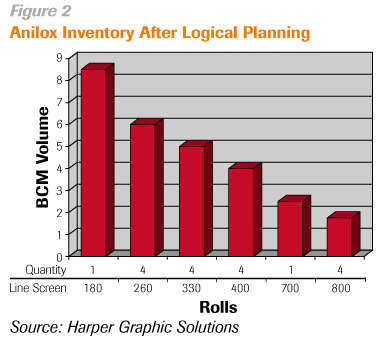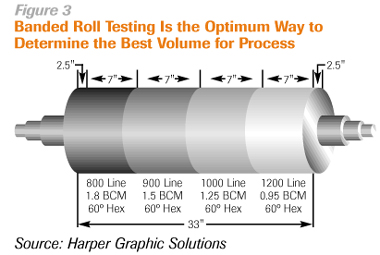Standardizing Anilox Rolls
- Published: July 01, 2003, By David Watson, Harper Graphic Solutions
Let's face it. In a time when business is being lost over the smallest margins, we must look at every part of the system, evaluate it, and become as efficient as possible. We all know if the press is not running and producing saleable product, dollars are being lost.
You invest in the best inks, plates, and sticky back you need to make sure you have the right roll to produce the job. Anilox rolls are one of the key elements in producing saleable product. Standardization of anilox roll inventory can help add profits to the bottom line.
What Is Anilox Roll Standardization?
Today most converters typically need an 18-20-roll inventory to handle all their printing needs. Too often I see 30-plus rolls per press while visiting a pressroom. Not only is this tying up dollars, it can be very confusing if proper documentation does not accompany each roll (see Figure 1).
According to John Perkins, general manager of Ample Industries, Nixa, MO, “We color code and stamp all of the journal ends of the anilox rolls so when walking by the press, a quick visual check can tell anyone what rolls are in what station at that time.”

Based on product mix, anilox roll inventory can be reduced and anilox rolls can be streamlined to match the unique challenges your specific process presents.
You must be able to identify and inventory the minimum quantity of anilox rolls for all your printing needs, and then standardize this inventory across your pressroom for greater consistency and profitability (see Figure 2).
From the outside looking in, this process can appear overwhelming; however, if you start with one press, standardization can be achieved easily.
Let's first address a couple of questions that will help us in the standardization process.
What is the product mix you currently run on press? There is no need to have process rolls if all you print is line work or vice versa.
Next, in what condition is your current inventory? If you do not have a recent inventory audit, I suggest conducting an audit to find out your current roll inventory.
If you have internal methods of measurement and verification, look at the documentation for each roll. Are the rolls new or worn out? It may be a good time to replace worn-out rolls or rolls you forgot about and do not use anymore.

Old, used rolls can be reconditioned and most of the time will be less than the price of a new core.
Do the rolls have damage to the face or edges? You may have some rolls that have damage on the face that your press staff has had to mount around for some time, or they may have placed a damaged roll aside, and it becomes dust covered and forgotten. These questions need to be addressed prior to standardizing.
Now that you know your product mix and current roll inventory, you can start the standardization of volumes. Experience tells us volume is the most important attribute of the anilox roll. It determines the amount of ink on the roll. What volume is right for you? A banded anilox test can find the correct volume needed for process work (see Figure 3).
Once you have determined, through a banded anilox test, the proper volume, purchase a matching set of five at the same volume for your process work. Four rolls will be in the press and one will be for backup in case of damage.
If a banded anilox roll test is not feasible, there are a number of anilox roll calculators out there, or consult your anilox supplier for assistance. Line work and vignettes can be achieved with one volume depending on the line screen and percent dot being held in the image. Solids, line work, and varnishes also can be obtained with one volume.

There are always going to be exceptions to the rule: If you are running white on film or specialty inks such as metallics, fluorescents, scratch-and-sniffs, etc., you may need a specialty roll.
In all cases, if you meet with your ink supplier and they are aware of the ink volume you will be running, they can formulate and mix ink that is volume specific. Having five different rolls ranging from volumes of 6.0 to 4.0 is unnecessary. This can all be accomplished with one volume.
Why Standardize Your Anilox Roll Inventory?
Standardizing anilox rolls gives press staff ownership of the rolls. First, each press has the right number of rolls for its work. Staff members are aware these rolls belong to their press; they are responsible for taking care of and maintaining them.
Too often in multi-shift operations with a large anilox roll inventory, damage can and will occur to a roll. The damaged roll is either hidden or placed in the back so no one can find it because the staff is worried about getting into trouble. No one takes responsibility for the roll.
Sometimes favorite rolls have a tendency to be hidden from shift to shift because staff members don't want anyone finding their favorite roll.
If a roll is damaged, it can be tracked through documentation and taken out and sent back for reconditioning. All these issues can be addressed through the standardization of inventory.
“At Ample Industries,” Perkins states, “pressmen love to have their anilox roll inventory standardized. Roll standardization takes the guesswork out of finding the right roll for that particular job.”
Standardizing anilox rolls will decrease set-up times and waste. Press assistants no longer need to hunt down that 360/5.0 that was in the press the last time they ran that job. They have it press side and available.
Each hour a press sits idle costs money. By each press having its own rolls and standard volumes, changeover times are decreased resulting in more jobs produced per hour and greater profits to the bottom line. By standardizing anilox roll inventory, Ample Industries has “cut set-up time and spoilage in half,” Perkins says.
Repeat jobs will be more consistent. You have the job specifications documented, and they are in the job jacket or database from the last time the job was run. The rolls are press specific. Simply place the rolls back in the press and go.
No longer will you ask: “Was it the 360 with a 4.5, 5.0, or 5.5 volume on the anilox roll we used the last time?” All your 360s now have the same volume and are press specific.
According to Perkins, “We know from documented history what the anilox selection is, and we can put any job in any of our presses and get the same consistency time and time again.”
Standardizing anilox roll inventory will reduce ink cost. If your ink supplier is formulating volume-specific ink, it is press ready, and toning the ink on press is no longer necessary once a correlation has been established. This will decrease the amount of ink in inventory.
Too often, ink is toned on press; nothing is documented; and it is placed on a shelf and forgotten. Next thing you know, the job comes back up, new ink is ordered, toned over, and placed on a different shelf.
Before you know it, you have five partial gallons of the same ink for the same job that have been toned and no one knows why or what color they really are because when they were toned, nothing was documented.
How Can You Afford to Standardize Your Existing Inventory?
Anilox rolls are a costly investment. Standardizing existing rolls can take some time. However, if you look at the return on investment and work with your supplier, the process does not have to be overwhelming. Start with one volume on one press and work from there.
Most facilities do not have a huge anilox roll budget; however, by looking at dollars lost during changeovers, ink toning, and setups, standardization is justifiable. Changeover and set-up times will decrease, toning of inks will decrease, ink cost will go down, and throughput will go up.
By running more efficiently, more work is being produced during regular work hours, and overtime is decreased. Profits will go up.
My question is not: “How can you afford to standardize?”, but rather: “How can you afford not to standardize your inventory?” It will more than pay for itself in a short time.
Anilox rolls are a costly investment. There is no need to have 20-30 rolls for each press anymore when job requirements can be met with a manageable inventory of anilox rolls. Standardization of anilox rolls is an effective method of controlling issues in the pressroom.
By standardizing anilox roll inventory, companies can give ownership to the pressmen, cut down on changeover times, control bottom-line ink cost, and become more consistent from run to run and job to job while increasing bottom-line profits.
David Watson is the southeast graphic consultant for Harper Graphic Solutions, a div. of Harper Corp. of America, Charlotte, NC. Watson earned a BA in printing production management from Appalachian State Univ. and an MA in graphic communications from Clemson Univ. He was been with Harper Corp. for two-plus years and can be reached at 704/588-3371 or dwatson@harperimage.com.
The views and opinions expressed in Technical Reports are those of the author(s), not those of the editors of PFFC. Please address comments to author(s).










